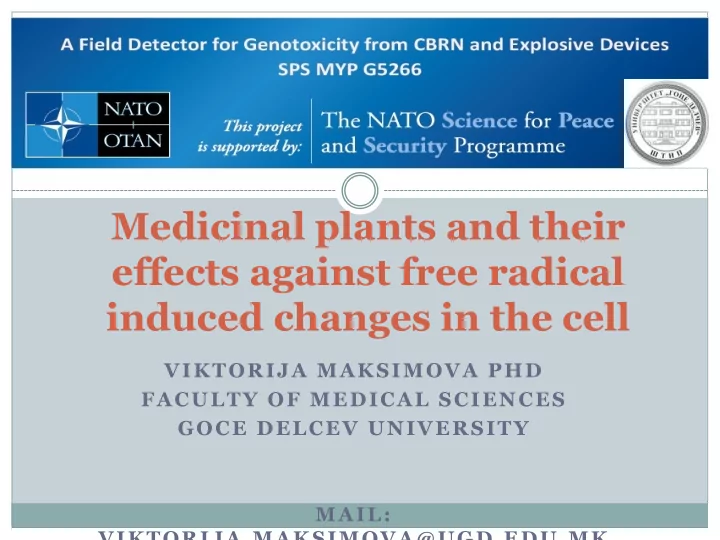

Medicinal plants and their effects against free radical induced changes in the cell VIKTORIJA MAKSIMOVA PHD FACULTY OF MEDICAL SCIENCES GOCE DELCEV UNIVERSITY MAIL: VIKTORIJA.MAKSIMOVA@UGD.EDU.MK
Main interest: pharmacognosy, medicinal plants Pharmacokinetic and pharmacodinamic variability on the effects of certain plant extract v.s pure phytochemical constituent is more than possible.
Reactive oxygen species However, a more Reactive oxygen species or ROS (superoxide, hydroxyl, and peroxy important activity of radicals, and hydrogen peroxide) and physiological ROS and Reactive nitrogen species or RNS RNS is their participation (nitric oxide and peroxynitrite). in many enzymatic and (Hydrogen peroxide H 2 O 2 and gene-catalyzed processes. peroxynitrite −OONO OONO https://www.biotek.com/resources/white-papers/an-introduction- to-reactive-oxygen-species-measurement-of-ros-in-cells
Free radicals induced changes in the cell Free radical generation is one of the most regulated processes in cells Oxidative stress is a secondary consequence of cellular malfunctions produced by intrinsic and extrinsic factors. https://www.ncbi.nlm.nih.gov/pmc/articles/PMC3520038/
Oxidative stress: imbalance between ROS and antioxidants Maintenance of optimal ROS and RNS levels is a critical condition for normal functioning of physiological processes. Disturbance of regulation of ROS and RNS signaling might lead to the activation of dangerous enzymatic cascades and stimulation of numerous pathological states including cardiovascular diseases, hypertension, diabetes mellitus, cancer and carcinogenesis, inflammation, and aging. Thus toxic effects of ROS and RNS signaling can depend not only on direct attack of these species on biomolecules (although it might be true for reactive hydroxyl and peroxy free radicals) but to be a consequence of disruption of their physiological levels due to enhancement or reduction of reactive species Role of reactive oxygen species in cell signaling pathways, Biochemical and biomedical aspects of oxidative modification, 2001
Electrochemistry as a tool for estimation of antioxidant capacity
ROS and Ca 2+ two cross-talking messengers ROS and Ca 2+ are two cross-talking secondary messengers in numerous cellular processes. Interactions between Ca 2+ and ROS signaling systems can be both stimulatory and inhibitory. There is a delicate balance between the beneficial and detrimental consequences of Ca 2+ and ROS regarding the mitochondrial function. Capsaicin is TRPV1 receptor (Ca 2+ –channel) agonist.
Activation of TRPV1 receptors https://hybridpharm.com/wp-content/uploads/2018/07/TRPV1receptor-activation.png
Molecular mechanisms of apoptosis=two ways leading to cell death
Methods for determination of cytotoxicity of capsaicin MTT and LDH assays MTT assay Ø Colorimetric analysis for measuring the metabolic activity of living cells Ø MTT ((3-(4,5-Dimethylthiazol-2-yl)-2,5-diphenyltetrazolium bromide) –yellow is reduced to violet-blue formazan product Ø Method principle : (λ = 570 nm)
Methods for determination of cytotoxicity of capsiaicn: MTT and LDH assays LDH assay Ø Method for estimation of cell membrane integrity Ø LDH (lactate dehydrogenase) is an intracellular enzyme and it leaks at extracellular compartment in the case of cell necrosis (cell death) Ø Method principle (λ = 492 nm)
Capsaicin induces apoptosis through its TRPV1 receptor (Ca 2+ –channel) Effect of different capsaicin concentrations Effect of ethanolic Capsicum extracts on cell viability (MTT assay) on B104 (obtained from Capsicum genotypes: neuroblastoma cells, incubated for 1, 6 or 24 Vezena , Feferona , Bombona , Sivrija ) h. There is a significant difference in the on cell viability (MTT assay) treated for results for the effect of 100 µM capsaicin for 1, 6 or 24 h. Viability of the cells was 1 h compared to the effect for 6 h. compared to negative control (DMEM). Significance: # ( p < 0.05), **( p < 0.01) vs. DMEM.
ROS and genotoxicity …for further studies
Gratitude to NATO SPS project for supporting young researchers!
Recommend
More recommend